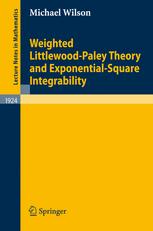

Most ebook files are in PDF format, so you can easily read them using various software such as Foxit Reader or directly on the Google Chrome browser.
Some ebook files are released by publishers in other formats such as .awz, .mobi, .epub, .fb2, etc. You may need to install specific software to read these formats on mobile/PC, such as Calibre.
Please read the tutorial at this link: https://ebookbell.com/faq
We offer FREE conversion to the popular formats you request; however, this may take some time. Therefore, right after payment, please email us, and we will try to provide the service as quickly as possible.
For some exceptional file formats or broken links (if any), please refrain from opening any disputes. Instead, email us first, and we will try to assist within a maximum of 6 hours.
EbookBell Team

5.0
78 reviewsLittlewood-Paley theory is an essential tool of Fourier analysis, with applications and connections to PDEs, signal processing, and probability. It extends some of the benefits of orthogonality to situations where orthogonality doesn’t really make sense. It does so by letting us control certain oscillatory infinite series of functions in terms of infinite series of non-negative functions. Beginning in the 1980s, it was discovered that this control could be made much sharper than was previously suspected. The present book tries to give a gentle, well-motivated introduction to those discoveries, the methods behind them, their consequences, and some of their applications.